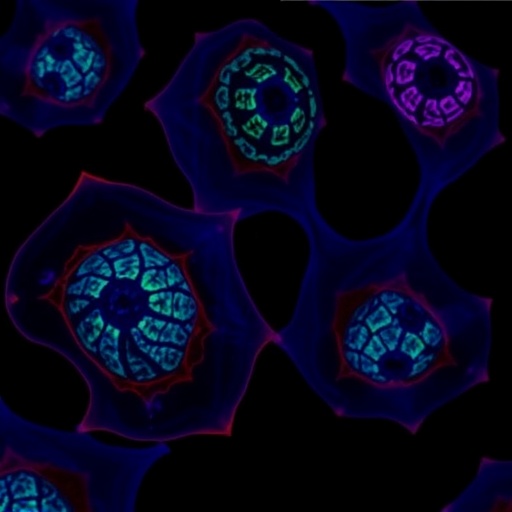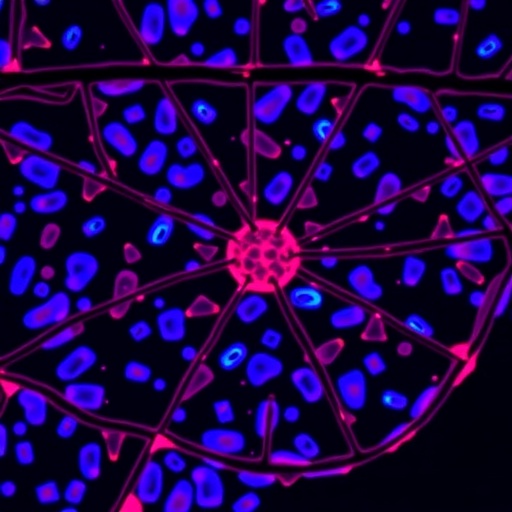In a groundbreaking study recently published in BMC Cancer, researchers have unveiled a novel mechanism underlying cervical cancer progression, spotlighting the enzyme PGK1 as a pivotal regulator of lipid peroxidation and tumor proliferation. This discovery paves the way for innovative therapeutic strategies against one of the most common cancers affecting women worldwide. Employing cutting-edge single-cell sequencing and transcriptome analyses, the research team delved deep into the tumor microenvironment, unraveling complex interactions influenced by liquid-liquid phase separation (LLPS) processes.
Cervical cancer remains a critical global health challenge, ranking as the fourth most prevalent cancer among females. Despite advances in screening and HPV vaccination programs, the disease continues to claim hundreds of thousands of lives annually, highlighting the urgent need for more refined diagnostic and treatment modalities. Traditional approaches, such as cytology and HPV testing, though valuable, fall short in offering precise prognostic insight or targeted therapies adaptable to tumor heterogeneity. The current study breaks new ground by integrating LLPS biology into the molecular landscape of cervical cancer.
Liquid-liquid phase separation is a biophysical phenomenon whereby specific proteins and nucleic acids condense into membraneless organelles, thereby orchestrating critical cellular processes. Aberrations in LLPS have been implicated in a variety of diseases, including neurodegeneration and cancer, yet their contribution to cervical carcinogenesis remained largely unexplored until now. Utilizing publicly available transcriptomic datasets from the GEO database, the researchers meticulously cataloged gene expression patterns linked to LLPS across six distinct cell types within cervical tumors.
.adsslot_GN5jDvoLgt{ width:728px !important; height:90px !important; }
@media (max-width:1199px) { .adsslot_GN5jDvoLgt{ width:468px !important; height:60px !important; } }
@media (max-width:767px) { .adsslot_GN5jDvoLgt{ width:320px !important; height:50px !important; } }
ADVERTISEMENT
The study identified a cohort of seven genes associated with LLPS that demonstrated prognostic relevance, serving as the backbone of a robust predictive model. This model stratified patients into high and low-risk groups based on their LLPS scores, with the former exhibiting significantly poorer survival outcomes. Notably, these divergent prognoses seem intricately connected to variations in the tumor’s immune microenvironment, where shifts in immune cell populations, such as CD8+ T cells, M0 macrophages, and regulatory T cells, may play critical roles in modulating tumor progression and immune evasion.
A particularly compelling finding of the study is the identification of PGK1 (phosphoglycerate kinase 1) as a core gene tightly linked to cervical cancer prognosis and immune infiltration dynamics. PGK1 is a glycolytic enzyme traditionally known for its role in energy metabolism; however, this research highlights its involvement far beyond metabolic regulation. Correlation analyses revealed that PGK1 expression is intricately connected to pathways governing lipid peroxidation, a process characterized by oxidative degradation of lipids that can influence cell fate decisions, including ferroptosis—a form of programmed cell death driven by iron-dependent accumulation of lipid peroxides.
To elucidate the functional impact of PGK1 downregulation, the researchers employed state-of-the-art immunofluorescence techniques and flow cytometry assays. These analyses demonstrated a marked increase in lipid peroxidation levels following PGK1 knockdown in cervical cancer cells, indicating that PGK1 acts as a suppressor of oxidative lipid damage in the tumor milieu. This insight provides a crucial link between metabolic rewiring and oxidative stress in cancer pathobiology, suggesting that targeting PGK1 could sensitize cancer cells to lethal lipid peroxidation.
Integral to the study was the comprehensive examination of the tumor immune microenvironment influenced by LLPS-related gene expression. Through immunohistochemistry staining, the researchers confirmed the association between key signature genes—including PDIA6, PGK1, ASPH, and FNDC3B—and immune infiltration patterns seen during tumorigenesis. These genes may contribute to shaping immunomodulatory landscapes, potentially affecting responses to immunotherapies and overall tumor aggressiveness.
The significance of the LLPS-related gene signature extends beyond prognostication; it holds promise for re-defining cervical cancer subtypes based on molecular and immunological attributes. This paradigm shift could facilitate precision oncology approaches, enabling clinicians to tailor treatments according to the unique molecular fingerprints of a patient’s tumor while considering their tumor’s immune contexture. Ultimately, such stratification could improve therapeutic responses and long-term outcomes for cervical cancer patients.
From a broader biomedical perspective, this study exemplifies the growing recognition that phase separation biology intersects profoundly with cancer research. The modulation of LLPS-associated proteins and pathways offers untapped therapeutic avenues, especially in cancers characterized by metabolic adaptation and immune suppression. By unraveling the role of PGK1 within this framework, the researchers contribute a crucial piece to the puzzle of how metabolic enzymes can moonlight as regulators of cellular stress and tumor behavior.
Additionally, the employment of integrative computational analyses combined with rigorous experimental validation signifies an exemplary approach to cancer research. By leveraging public genomic data and validating hypotheses using in vitro and in vivo models, the study sets a standard for future multi-omics investigations poised to decode the complexities of malignancies such as cervical cancer. This multi-layered methodology accelerates the translation from data-driven discoveries to clinical applications.
The confluence of lipid peroxidation mechanisms and cancer metabolism warrants further exploration, particularly in the context of emerging therapies like ferroptosis inducers, which could be potentiated by targeting PGK1. As lipid peroxidation contributes to cellular demise under oxidative stress, manipulating these pathways could selectively eliminate cancer cells while sparing normal tissue. Thus, PGK1 inhibitors or modulators may become part of combination regimens designed to overcome resistance to conventional therapies.
Finally, this comprehensive study reaffirms the necessity to look beyond traditional oncogenic drivers and to embrace novel biological phenomena such as LLPS in the fight against cancer. By connecting phase separation dynamics, metabolism, oxidative stress, and immune modulation, the findings open a multidimensional vista for innovative research and therapeutic development. As cervical cancer continues to burden millions globally, insights like these are essential for turning the tide against this formidable disease.
Subject of Research: Cervical cancer, LLPS-related gene signature, PGK1 function, lipid peroxidation, tumor proliferation, immune microenvironment.
Article Title: Downregulation of PGK1 promotes lipid peroxidation and suppresses proliferation in cervical cancer revealed by liquid-liquid phase separation-related gene signature.
Article References:
Zhang, B., Li, Z., Yang, Z. et al. Downregulation of PGK1 promotes lipid peroxidation and suppresses proliferation in cervical cancer revealed by liquid-liquid phase separation-related gene signature. BMC Cancer 25, 1269 (2025). https://doi.org/10.1186/s12885-025-14637-4
Image Credits: Scienmag.com
DOI: https://doi.org/10.1186/s12885-025-14637-4
Tags: biophysical phenomena in disease mechanismscervical cancer global health challengeHPV vaccination impact on cervical cancerinnovative therapeutic strategies for cervical cancerlipid peroxidation and tumor proliferationmolecular landscape of cervical cancer researchPGK1 downregulation in cervical cancerphase separation in cellular processessingle-cell sequencing in cancer researchtargeted therapies for tumor heterogeneitytraditional vs modern diagnostic approaches in cancertumor microenvironment and LLPS interactions




